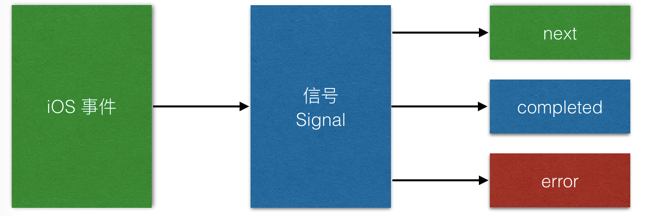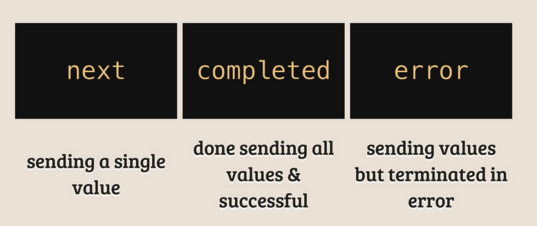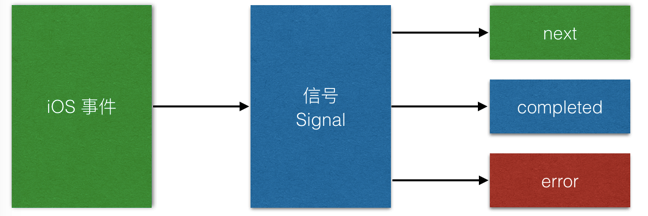本文主要是介绍RAC的简单使用,希望对大家解决编程问题提供一定的参考价值,需要的开发者们随着小编来一起学习吧!
今天是周末,临近年底,工作上遇到不可抗力,会有点一些变动!这多少会让人有一点静不下来,但需克制,Reactive Cocoa是今天的主角!
废话不多说,今天聊聊Reactive Cocoa的常见使用!
Reactive Cocoa 是一个非常重量级一个框架,个人非常欣赏这个团队!!
为什么说Reactive Cocoa非常的牛!!
我们所熟知的iOS 开发中的事件包括:
- Target
- Delegate
- KVO
- 通知
- 时钟
- 网络异步回调
而 ReactiveCocoa ,就是用 信号 接管了 iOS 中的所有事件;也就意味着,用一种统一的方式来处理iOS中的所有事件,解决了各种分散的事件处理方式,显然这么一个庞大的框架学习起来也会比较难!而且如果习惯了iOS原生的编程,可能会觉得不习惯!
先看一个图:
从这张图中,可以看出利用 信号,ReactiveCocoa接管 iOS 的所有事件,抛给开发者对事件作出三个相应反应;
可以用一张图来简要说明
RAC 的特点
- 通过 block 函数式 + 链式 的编程,可以让所有相关的代码继承
在一起! - 使用时需要注意循环引用,@weakify(self) / @strongify(self) 组合解除循环引用;
下面用iOS开发中常见的五种事件来说明ReactiveCocoa的常见用法!
下载框架:
- 新建项目
- 进入终端,建立 Podfile,并且输入以下内容
- # Uncomment this line to define a global platform for your project
platform :ios, ‘8.0’- # Uncomment this line if you’re using Swift
use_frameworks!
pod ‘ReactiveCocoa’, ‘~> 4.0.4-alpha-4’
- 版本说明:
2.5 纯 OC
3.0 正式版支持 Swift 1.2
4.0 测试版支持 Swift 2.0
在终端输入以下命令安装框架
$ pod install
KVO 监听
程序实现: 监控Person name的属性变化;在touchesBegan中改变name的值,并将变化体现在UILabel上,实现KVO的监控功能;
* 注意,RAC 的信号一旦注册不会主动释放
* 只要在 block 中包含有 self. 一定会出现强引用
* 需要使用 @weakify(self) / @strongify(self) 组合使用解除强引用
Person类: #import <Foundation/Foundation.h> @interface Person : NSObject @property (nonatomic, strong) NSString *name; @end// ViewController.m #import "ViewController.h" @import ReactiveCocoa; #import "Person.h" @interface ViewController () @property (weak, nonatomic) IBOutlet UILabel *nameLabel; @property (nonatomic, strong) Person *person; @end@implementation ViewController- (Person *)person {if (!_person) {_person = [[Person alloc] init];}return _person; } - (void)viewDidLoad {[super viewDidLoad];[self demoKvo]; } - (void)touchesBegan:(NSSet<UITouch *> *)touches withEvent:(UIEvent *)event {self.person.name = [NSString stringWithFormat:@"zhang %d",arc4random_uniform(100)]; } - (void)demoKvo {@weakify(self)[RACObserve(self.person, name)subscribeNext:^(id x) {@strongify(self)self.nameLabel.text = x;}]; } @end
文本框输入事件监听
#pragma -mark 文本框输入事件监听 /*** 为了测试此函数,增加了一个nameText;监听文本框的输入内容,并设置为self.person.name*/ - (void)demoTextField {@weakify(self);//创建一个冷信号 使用subscribeNext订阅一个信号[[self.nameText rac_textSignal]subscribeNext:^(id x) {@strongify(self);NSLog(@"%@",x);self.person.name = x;}]; }
文本框组合信号
#pragma -mark 文本信号组合 /*** 为了验证此函数,增加了一个passwordText和一个Button,监测nameText和passwordText* 根据状态是否enabled*/ - (void)textFileCombination {id signals = @[[self.nameText rac_textSignal],[self.passWordText rac_textSignal]];@weakify(self);[[RACSignalcombineLatest:signals]subscribeNext:^(RACTuple *x) {@strongify(self);NSString *name = [x first];NSString *password = [x second];if (name.length > 0 && password.length > 0) {self.loginButton.enabled = YES;self.person.name = name;self.person.password = password;} else {self.loginButton.enabled = NO;}}]; }
按钮监听
#pragma -mark 按钮监听 /*** 验证此函数:当loginButton可以点击时,点击button输出person的属性,实现监控的效果*/ - (void)buttonDemo {@weakify(self);[[self.loginButton rac_signalForControlEvents:UIControlEventTouchUpInside]subscribeNext:^(id x) {@strongify(self);NSLog(@"person.name: %@ person.password: %@",self.person.name,self.person.password);}]; }
代理方法
#pragma -mark 代理方法 /*** 5、验证此函:nameText的输入字符时,输入回撤或者点击键盘的回车键使passWordText变为第一响应者(即输入光标移动到passWordText处)*/ - (void)delegateDemo {@weakify(self)// 1. 定义代理self.proxy = [[RACDelegateProxy alloc] initWithProtocol:@protocol(UITextFieldDelegate)];// 2. 代理去注册文本框的监听方法[[self.proxy rac_signalForSelector:@selector(textFieldShouldReturn:)]subscribeNext:^(id x) {@strongify(self)if (self.nameText.hasText) {[self.passWordText becomeFirstResponder];}}];self.nameText.delegate = (id<UITextFieldDelegate>)self.proxy; }
通知
#pragma -mark 通知 /*** 验证此函数:点击textFile时,系统键盘会发送通知,打印出通知的内容*/ - (void)notificationDemo {[[[NSNotificationCenter defaultCenter] rac_addObserverForName:UIKeyboardWillChangeFrameNotification object:nil]subscribeNext:^(id x) {NSLog(@"notificationDemo : %@", x);}]; }
看来看看这张图,会不会清晰很多?
这么一个强大的RAC,赶紧来试试吧!
以上源码在gitHub:Demo链接
参考资料
这篇关于RAC的简单使用的文章就介绍到这儿,希望我们推荐的文章对编程师们有所帮助!









